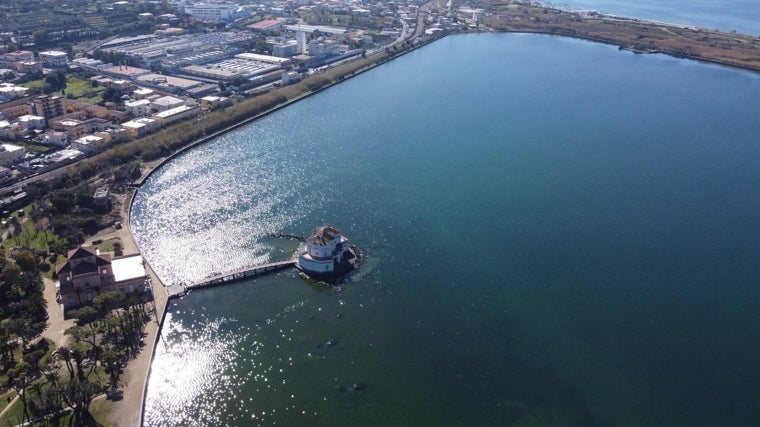The residents of Bacoli, a coastal town 28 kilometers from Naples, witnessed a few days ago of an unusual show: stone walls, covered with algae, slowly emerged from the waters of Lake Fusaro. This is the remains of a luxurious Roman villa, … Submerged for centuries and now returned to light by the effect of tide and ‘bradisismo’, a typical phenomenon of this area, the flowering fields (‘burning’, according to Greek etymology).
Here is the largest active volcanic boiler in Europe, with a diameter of 13 kilometers. The ‘Braradisismo’, which has intensified in recent years, is causing the elevation of seabed in the Gulf of Pozzuoli and in the volcanic lakes of the Flugreos fields, among which is Fusaro. In this area, the Ladies linked to ‘Bradisismo’ occur, that is, a soil deformation that implies slow sinking phases, alternated with elevation phases (usually one centimeter per year), because of the accumulation of gas and magma.
Precisely, when the seabed for the ‘Bradisismo’, the residents of Bacoli (26,000 inhabitants Napolitano) were raised fascinated before a new historical discovery that attests to their link with the past.
Sumptuous villa
Its mayor, Josi Gerardo Della Ragionehe announced it enthusiastically: «Remains of walls and stays of Roman era have appeared that surely belonged to A sumptuous villa with thermal waters of imperial era«(The period from 27 AC to 476 AD). »Some areas of ‘Opus reticulatum’ [técnica de mampostería romana] They are already appreciable to the naked eye, “the Bacoli councilor has described on social networks. »They are even occupied by the ducks that park in the Lake Basin, a few steps from The vanvitellian casina«.
Remains that have emerged
Josi Gerardo Della Ragione
This old 18th century building is also known as Royal Bourbon Casino of the Fusaro. It rises on a small island in Lake Fusaro, in an area that was used at the time for hunting and fishing, given the optimal environmental conditions of the lake that favored such an activity. The discovery is, in the opinion of the mayor of Bacoli, as A trip between Bourbon Wonders and Remains of the Imperial Era“What will be subject to studies by the Superintendence of Naples.”
Historical importance
Experts highlight the historical importance of this finding. This is explained by Superintendent Mariano Nuzzo: “The presence of masonry structures in Fusaro suggests a residential and productive context, probably linked to villas.” 2000 years ago, the Flégrea coast was famous for its sumptuous residenceswith several rooms, lush gardens and sometimes hot springs. Not far are also the so -called ‘Grotte Dell’acqua’, associated with old Roman thermal facilities.
Much more than simple vacation complexes, these villas often also incorporated infrastructure dedicated to agriculture, fishing and aquaculture. Here came the Roman elites to enjoy the pleasant weather and the natural resources of the environment. Behind this finding, the attention is also put on the aforementioned phenomenon of ‘Bradisismo’, a reason for constant concern for the inhabitants of the area, because they step on a floor that writes and erases the story.
Volcanic field
The Flégreos fields, which include the municipalities of Bacoli, Monte di Procida, Pozzuoli, Quarto, Giugliano and part of the city of Naples, is a populated area through half a million people. Unlike Vesuvio, which destroyed the Roman cities of Pompeii and Herculano in 79 AD, the flowering fields are not characterized by a single main volcanic building, but are an active volcanic field with Several craters, some submarines. This boiler was formed 39,000 years ago, after a violent eruption was the empty of Magma.

Aerial view of the area
Josi Gerardo Della Ragione
It’s about A much more active area than the Vesubioalthough thousands and thousands of small earthquakes since the 1950s have weakened the boiler. «Only in four days, Between February 15 and 19, we have registered 692 earthquakes. The seismic sequence of longer duration and frequency of the shaking of the last forty years has been treated, ”says Mauro Di Vito, director of the Vesubian Observatory. The maximum magnitude was 3.9, but the vast majority was less than 1.0.
The ground rises
In short, ‘Bradisismo’, a phenomenon of nature that is continuously changing this land, has been decisive in the new discovery. Superintendent Nuzzo confirms that, in recent years, ‘Bradisismo’ has accelerated the resurgence of old submerged remains. The progressive elevation of the land has made visible structures that had remained covered by water for centuries, but at the same time it has raised New challenges for conservation.
According to a study by the National Institute of Geophysics and Vulcanology, the ground level in the Lake Fusaro area has been constantly rising since 2005. Only in 2024, it won 20 centimeters, carrying the total elevation around 1.38 meters in less than two decades. The Superintendency is studying specific interventions for the conservation and improvement of the structures that have been discovered.
This has been explained by Superintendent Mariano Nuzzo: «In Fusaro an in -depth study will be necessary to understand the context of discoveries and identify protection strategies. We are studying the possibility of making integrated visit routes, using digital tools and augmented reality to virtually reconstruct these ancient environments and allow the public to immerse themselves in history ».
#volcanic #phenomenon #brings #light #Roman #village #Neapolitan #lake

